Downtown Minneapolis and St. Paul retain a handful of historic theaters built in the early 20th century, but dozens of others are gone — lost to fire or old age or the ceaseless cycles of redevelopment.
Two of the more intriguing of these lost theaters, one in each downtown, bore the same name — the Metropolitan.
The Minneapolis Metropolitan was notable for an embarrassing design flaw, and later became the scene of an alibi concocted by a notorious murderer. St. Paul's Metropolitan was in many ways the grander of the two, and its architect went on to play a crucial role in designing an epic American building — Grand Central Terminal in New York City.
Both theaters, known as opera houses because they were designed for live theatrical and musical performances, opened in the 1890s and came down within a year of each other in the 1930s.
The Metropolitan Opera House in Minneapolis (320 Marquette Av.) made its debut in 1894. It was known initially as the New People's Theater but was renamed the Metropolitan just six months later under new ownership.
Vaguely Romanesque Revival in style, the theater was designed by Harry G. Carter, a Minneapolis architect who specialized in entertainment venues (including brothels, at least one of which he designed for a prominent local madam).
Another Minneapolis designer, Lawrence McIvor, decorated the theater auditorium, which had two balconies and 1,500 or more seats. On the outside, the theater offered up a brownstone facade, an arched entrance, and a corner tower. Inside, the playhouse was the usual plasterer's holiday, with plenty of decorative effects to enliven the show.
It's fair to say the theater didn't get off to a good start.
During construction, the steel arch forming the proscenium collapsed. Fortunately, no one was hurt. A bigger problem became apparent as the theater neared completion, when it was discovered Carter had somehow neglected to provide room for a box office. After some last-minute scrambling, one was carved out of a cramped space beneath a stairway, and remained in use until the theater closed.
Opening night was March 24, 1894. All the usual dignitaries were on hand, led by Minneapolis Mayor William Eustis, who penned a poem for the occasion. "May the people's stage, make this, our age/ More grand and fair in story," it began, and didn't get any better after that.
Bad poetry aside, the theater drew large crowds in its early years. On Dec. 3, 1894, a handsome young man-about-town and all-around bad boy named Harry Hayward spent an evening there. But the drama was of his own making. He'd hired a man to murder his girlfriend, Catherine "Kitty" Ging, and his night at the Metropolitan merely served to establish an alibi. Hayward's cover story soon collapsed, however, and a year later he was hanged for his crime.
A grand theater
St. Paul's Metropolitan Opera House was located at 100 E. 6th St., between Minnesota and Robert streets. It opened in December 1890, nearly two years after the city's historic Grand Opera House on Wabasha Street burned down.
The fire had left St. Paul without a top-flight venue for plays and operas, and civic leaders immediately began laying plans for a new opera house. A syndicate led by retailer Robert Mannheimer eventually raised $500,000 for what became the Metropolitan, which was built as part of a project that included a new eight-story office building along 6th.
The architect in charge was James Reed, who would go on to have a fascinating career. In 1891, Reed, whose real talent was as an engineer, formed a partnership with Allen Stem. The firm of Reed and Stem became very successful, designing scores of buildings and homes in St. Paul, as well as railroad stations around the country.
But their biggest commission was for Grand Central Terminal. Although another architectural firm later took over much of the design under highly questionable circumstances, Reed is credited for the terminal's ingenious plan connecting multiple levels and types of train services. He died, probably from stress and exhaustion, in 1911, two years before the huge terminal opened.
For the Metropolitan, Reed designed its adjacent office building and also was responsible for the theater's general layout. McElfatrick and Son of New York took charge of decorating the double-balconied, 1,800-seat theater. The office building, faced in granite and brick, was very plain, but the theater offered an array of ornate plasterwork in a gold, ivory and brown color scheme. "A Splendid Theater, Leading in Many Respects, Anything of the Kind in America," declared a perhaps overly enthusiastic headline in the St. Paul Pioneer Press.
Opening night on Dec. 29, 1890, attracted the usual assortment of nabobs, including James J. Hill, for a performance of a light opera called "Robin Hood." A St. Paul Dispatch reporter opined that "the audience was as brilliant a one as was ever gathered together beneath the roof of any theater in St. Paul."
Over time, both Metropolitans faded as movies became popular and newer, larger downtown theaters were built, such as the State and Orpheum in Minneapolis and the New Palace (later Orpheum) and now vanished Capitol (later Paramount) in St. Paul.
The Great Depression turned out to be the final blow for the old theaters. St. Paul's Metropolitan and its adjoining office building were demolished in 1936. U.S. Bank Center, built in 1975, now occupies the site.
Minneapolis' Metropolitan fell to the wrecker in 1937. The site served as a parking lot until the Sheraton-Ritz Hotel was built on the block in 1963. The hotel is also gone, demolished in 1990. The 365 Nicollet apartments are now on the site of the vanished theater.
Larry Millett is an architecture critic and author of 14 nonfiction books and eight mystery novels. He can be reached at larrymillett.com.









